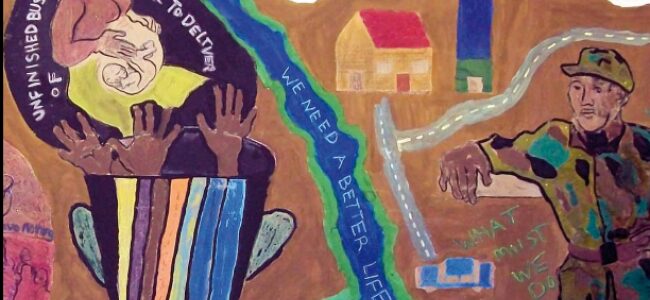The Khulumani Support Group organizes South African apartheid survivors into a collective voice in order to better provide support and advocate for reparations.
Uniting Survivors for Reparations and Justice
Khulumani, meaning to speak out, was founded by apartheid survivors and family members of victims in the early 1990s. At the time, the South African parliament was still debating legislation to establish a Truth and Reconciliation Commission (TRC). Khulumani is a membership-based organization of roughly 85,000 survivors of apartheid-related human rights violations. Its mission is to heal those hurt and divided by apartheid. It does this specifically by gaining government and corporate liability reparations to help heal and support the rebuilding of lives and communities.
 Image produced in a South African History Archives project, one of the six member organizations of the South African Coalition on Transitional Justice (SACTJ) in collaboration with Khulumani.
Image produced in a South African History Archives project, one of the six member organizations of the South African Coalition on Transitional Justice (SACTJ) in collaboration with Khulumani.
Unclaimed Reparations Could Fund Victim Trust
Once the South African TRC came to be, it identified approximately 22,000 apartheid survivors. Of those, the organization designated over 21,000 survivors as eligible for reparations. The TRC gave these survivors a Truth Reparations and Rehabilitation (TRR) number and invited them apply for the agreed Final Reparations Grant. About 16,000 did so. However, the grants were reduced to US $3,000, a quarter of the amount recommended by the TRC. Khulumani successfully assisted individuals eligible for grants in claiming their packages, with all but 14 individuals having received their payments. They have also asked the South African Department of Justice and Constitutional Development (DOJ) to provide them with the list of approximately 5,000 individuals who have not claimed their payments.
In most cases, these individuals hold societal positions where they do not need the money from the reparations grants. Khulumani would like for these individuals to claim their grants and commit the money to a trust fund to assist the thousands of victims who were not identified by the government. The DOJ agreed but has yet to comply. Khulumani follows up every thirty days with a Promotion of Access to Information Act application.
Involvement in the Truth and Reconciliation Process
Khulumani has also been involved in the process of identifying victims and survivors of apartheid-era human rights abuses. When the TRC was created, Khulumani’s founding members conducted extensive outreach to survivors and the families of victims across South Africa. The group recognized that without deliberate action to encourage the participation of these people in the TRC, there was no guarantee that they would even hear about its existence and objectives. Once the hearings commenced, Khulumani provided support and assistance to those called to testify.
Unfortunately, the Human Rights Violations Committee of the TRC, which conducted public hearings, was only able to hear the stories of about 2,000 individual survivors of apartheid-related abuses. This is a fraction of the number identified as victims. This was one of three committees created under the TRC. The Committee on Amnesty, regarding the perpetrators of abuses, decided the individual amnesty applications according to the essential requirements, namely actions whether or not actions were politically motivated and if the applicant made full disclosure of all relevant facts. The Committee on Reparation and Rehabilitation gathered evidence concerning the identity of victims, their fate, present whereabouts and the type of harm suffered. In theory, qualified survivors would receive reparations immediately after. However, this was not necessarily the case.
Continued Advocacy for Reparations
For example, reparations have been delayed or complicated by legal matters. In April 2014, Khulumani received a legal opinion from the DOJ inferring that a victim is someone who was found by the TRC to have suffered gross human rights violations and whose perpetrators were granted amnesty. This could mean that such notable cases as Steve Biko would not be considered a victim because the perpetrators responsible were refused amnesty. Nor would Neil Aggett be considered a victim because the perpetrators responsible did not apply for amnesty. Yet both Biko’s and Aggett’s families received TRR numbers, indicating inconsistencies in the reparations process.
Khulumani continues to advocate for the rights and reparations of survivors of apartheid-era human rights violations. In the time since the TRC has ended, it has become clear that the lists of identified victims did not begin to reflect reality. People are still coming forward to break the silence about their experiences and the consequences of apartheid on their lives and those of their children and grandchildren.
Khulumani and other civil society groups continue to lobby for the list to be re-evaluated, but so far all requests have been denied. As a result, reparations have been paid to only a section of the true victims of apartheid violence. As many as 100,000 people may have been excluded from the reparations process simply because they could not access the TRC justice mechanisms in the 18 months that the committee was operational. Thus Khulumani continues to advocate for a comprehensive and inclusive reparations regime in South Africa.